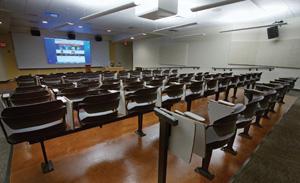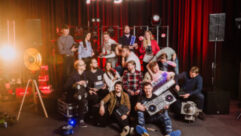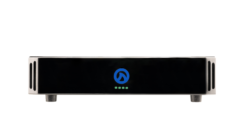

Professional Quality
Maintain clear communication between engineers, university officials, and contractors while installing high-definition projectors and 5.1 surround sound audio equipment on a deadline that was pushed up seven months.
According to Dan Lutz, associate director of University Teleplex, the faculty wanted to purchase 1080i or 1080p projectors for the screening room and lecture hall. “The problem with the 1080i and 1080p projectors in the $20,000 to $30,000 price range is that they don’t have a lot of ANSI lumens,” he says. The university looked at consumer models of true 1080i or 1080p projectors, but Lutz says they had only about 1,200 or 1,500 ANSI lumens. After reviewing a number of projectors, the university selected a 2,500 ANSI lumen 720p Christie DW30 projector for the screening room and a 5,000 ANSI lumen 720p Christie DW3K with an additional 1.7-2.5:1 zoom lens for the lecture hall.
CHALLENGE: Maintain clear communication between engineers, university officials, and contractors while installing high-definition projectors and 5.1 surround sound audio equipment on a deadline that was pushed up seven months.
SOLUTION: Appoint one person or team to review construction blueprints and constantly walk through the project to ensure the installation stays on time and on track.
The College of Communication, Information, and Media at Ball State University in Muncie, Ind., was literally busting at the seams. Enrollment in the college’s telecommunications department had doubled since the early 1990s, requiring the university to add more classroom space, offices, and production facilities.
After six years of planning and two years of construction, Ball State’s $21-million David Letterman Communication and Media Building, named after its most prominent graduate, opened in August 2007 —just weeks before the start of the fall semester. The building includes a $1-million production complex that features surround-sound editing suites and recording studios.
The lecture hall at the David Letterman Communications and Media Building at Ball State University in Muncie, Ind., seats 110 students and features top-of-the-line AV equipment.
Stan Sollars, instructor of telecommunications, oversaw the building’s AV equipment needs. “The entire production faculty agreed that high definition and surround sound were of paramount importance, because we were producing in those environments, and we had no proper surround sound or high-definition projection facility,” he says. “Outside of an edit suite, we really couldn’t see what the marketplace could see.” A 110-seat lecture hall and a 30-seat film screening room were included in plans for the new facility.
SCREENING EQUIPMENT
Engineers at the University Teleplex — which provides AV maintenance, engineering, and design support to the Ball State campus — drew up plans that met the AV equipment budget, including $46,000 for the screening room and $103,000 for the lecture hall. Later they installed the AV equipment in the lecture hall and screening room.
Due to a tight deadline, other portions of the AV equipment installation were outsourced to systems integrator Roscor Corp., Chicago, Ill., which also supplied the equipment.
“We gave the faculty options on the equipment, and many [choices] came down to how much money they had to spend,” says Jim Scott, senior broadcast engineer of University Teleplex. The lecture hall and screening room came in at the end of the project, he says. “They had allocated money for the rooms, but it came in pretty close to what they’d allocated, and there wasn’t a whole lot left over,” he adds.
A 10-inch AMX touch panel controls all equipment functions in both the screening room and lecture hall.
The audio equipment is essentially the same in the screening room and lecture hall. In each room, there are three Tannoy VNET12 HP speakers at the front, two Tannoy VNET12 speakers at the rear, and a Tannoy VNET 18DRSUB subwoofer. An Anthem AVM 50 surround sound processor from Sonic Frontiers International, an Extron MPX 423A media presentation matrix switcher, and a Shure UC14-84-UA wireless microphone are also incorporated into the setup.
CONSISTENT SOUND
Credit:
Ball State University broadcast and cinema majors developing audio for films or other big screen projects depend on the sound to be consistent as they move from the production studio to the screening room and lecture hall. But the size and shape of a larger room can have an affect on the sound quality.
“The bigger the room space, the more chances you have of acoustical anomalies,” says Derek Black, Eastern sales manager for Tannoy North America. Screening rooms or theaters are usually square or rectangle shaped. “You’ve got cosmetic and physical or architectural issues you have to deal with in that space that you probably wouldn’t in the studio,” he says. Additionally, speaker placement is also encumbered by the shape of the room. Rather than being set up in an arc shape for optimal 5.1 sound, they are often positioned in a straight line.
In the David Letterman Communication and Media Building, Tannoy Ellipse iDP reference monitors were used in the studios and Tannoy VNET speakers were used throughout the screening room and lecture hall. One important feature of the VNET speakers is their ability to be calibrated by a computer.
Instead of measuring out the physical distance between the speakers and arc, the VNET software allows the sound engineer or acoustician to program the delay capability down to the millisecond. “In lieu of being able to place them physically where they need to be for that proper arc, they’re able to delay the boxes,” Black says.
Firmware within the speaker can be controlled by a very simple graphic user interface running off a standard laptop, Black says. The Ethernet network cable connects to the laptop loaded with the VNET software, and each of the speakers in the 5.1 system are connected to each other by an Ethernet cable.
On the computer screen, the loudspeakers on the network will appear as minimized panels in the form of a status monitor icon, or “Monicon.” These are laid out to reflect the physical layout of the speakers within the venue so the user can monitor system status and component condition.
The Tannoy VNET12 HP loudspeakers are slightly larger and heavier than others previously installed on campus, requiring University Teleplex engineers to approach the installation differently to make sure the speakers remained in position.
In the lecture hall, the 48-pound VNET12 HP front loudspeakers are suspended from the ceiling above the Draper Onyx screen. “The lecture hall surface was a hard ceiling, drywall on metal studs,” says Jim Scott, senior broadcast engineer at Ball State University. “Plywood was added above the hard ceiling during the construction phase to give support.”
In the screening room, he says the loudspeakers were fixed behind the perforated Draper Polygon screen in front-inside recesses that were specified before construction started. The rear loudspeakers are wall mounted in both rooms.
Sollars says they selected the Tannoy VNET speakers because the speakers are self-powered and computer tunable (see “Consistent Sound,” right). “They image and cover quite well,” he says.
Other equipment in the screening room and lecture hall include a Toshiba HD-XA2 HD-DVD player, a Sony BDP-S1 Blu-ray Disc player, and Sony XLV-N900 VHS player, which are housed in Winsted consoles. A Dukane DVP505A document camera and a G5 Apple Mac Pro and a 30-inch screen are also included. An AMX NetLinx Integrated Controller with a 10-inch touch panel controls all equipment functions in the screening room and lecture hall.
In the telecommunications department’s previous building, Sollars says, “We had a shortage or lack of tie lines in the studios, which we’ve certainly made up for in the new building.” About 75,000 feet of audio, video, and data cable, supplied by Belden, was installed throughout the facility. “We can interconnect anything — digital or analog — anywhere,” he adds.
EMPHASIZING COMMUNICATION
During construction, Sollars says maintaining a clear line of communication between the faculty, the engineers, facility management, and general contractor W.A. Sheets Co. of Fort Wayne, Ind., was the biggest challenge. “There were times where we didn’t see things on the blueprint and, thankfully, had time to correct them,” he says.
Point and Click
________________________________________
For more information about the companies and products mentioned in Professional Quality, please visit the company Web sites.
AMX
www.amx.com
Apple
www.apple.com
Ball State University
www.bsu.edu
Belden
www.belden.com
Christie Digital Systems
www.christiedigital.com
Draper
www.draperinc.com
Dukane Corp.
www.dukcorp.com
Extron Electronics
www.extron.com
Roscor Corp.
www.roscor.com
Shure
www.shure.com
Sonic Frontiers International
www.anthemav.com
Sony
www.sonypictures.com
Tannoy North America
www.tannoy-speakers.com
Toshiba
www.toshiba.com
Winsted Corp.
www.winsted.com
ALSO:
Green is all the rage these day, and Ball State University ensured that its newest building was state-of-the-art eco-friendly. Find out how the AV equipment fits into that plan in Environmental Impact.
For example, the projector in the lecture hall had to be on the centerline of the room. The projector also is enclosed in a blimp, which required space above the ceiling to take in and exhaust air. During one of his frequent walkthroughs, Sollars noticed that a sprinkler pipe was running on the centerline.
“The sprinkler pipe was in the way,” he says. “I explained it to one of the university engineers, and he relayed our concerns in the weekly meeting with the contractors.” He adds that the contractors were able to use elbow joints to reroute the sprinkler lines, while the architects from MKSTD and Associates, also in Fort Wayne, shifted the lights from the centerline.
While Sollars says the AMX touch panels have “liberated the faculty from fumbling in front of our students with impossible remote controls,” Lutz says the AMX programming also was a challenge because they had new equipment and needed to write code for it. According to Scott, the building inauguration schedule was moved up about seven months — from January 2008 to June 2007 — in order for the building to be open for the fall semester. Although University Teleplex engineers have been writing code for the AMX touch panels for the last few years, Lutz says the time allowed to program on this project was shortened due to the tight time frame.
After all the challenges experienced on the project, the faculty and students have had a few months to settle into the new Letterman Communication and Media Building. Sollars says his favorite aspect of the whole endeavor was seeing the expressions of awe in the students’ faces. He adds that even Letterman himself was impressed with the new equipment when he visited Ball State University for the grand opening of the new building. “When he was in our main control room, he looked over at his two staff members and said ‘This kind of reminds me of CBS,’” Sollars recalls. “We smiled about that one.”
Katie Parrish is a technical writer based in Independence, Mo. She can be reached at [email protected].










